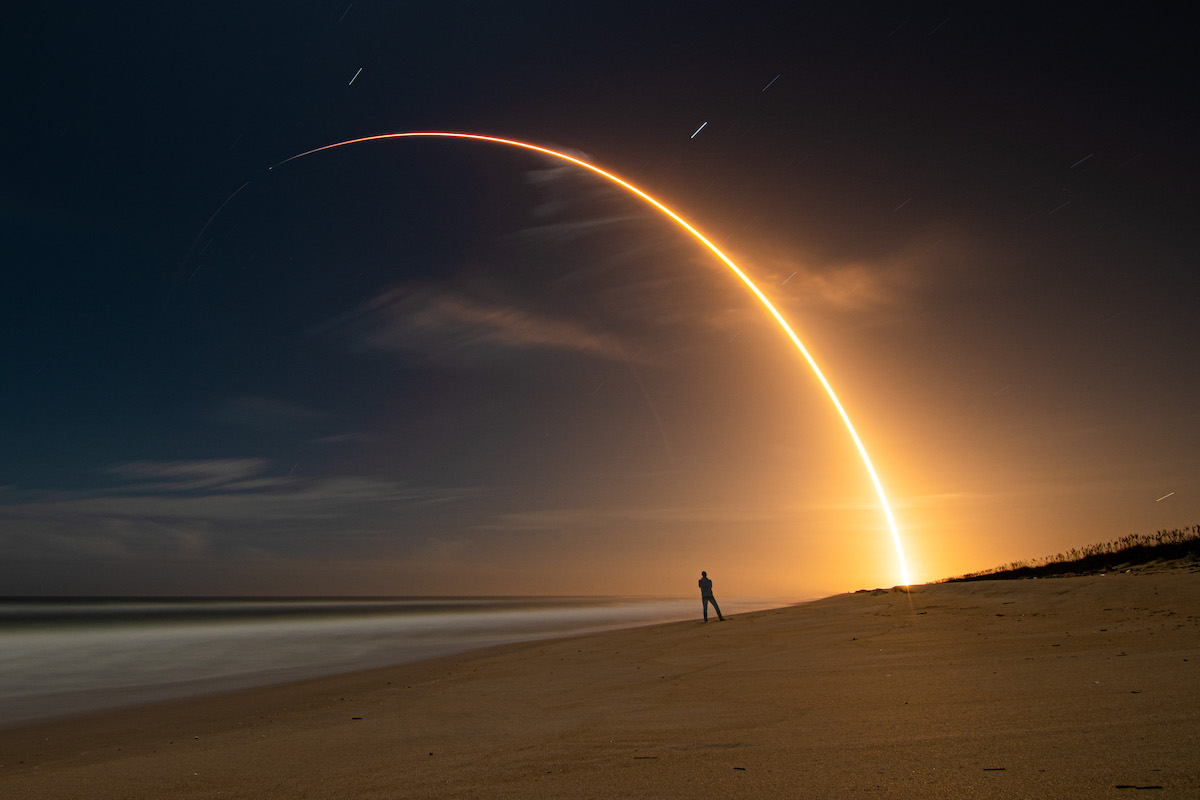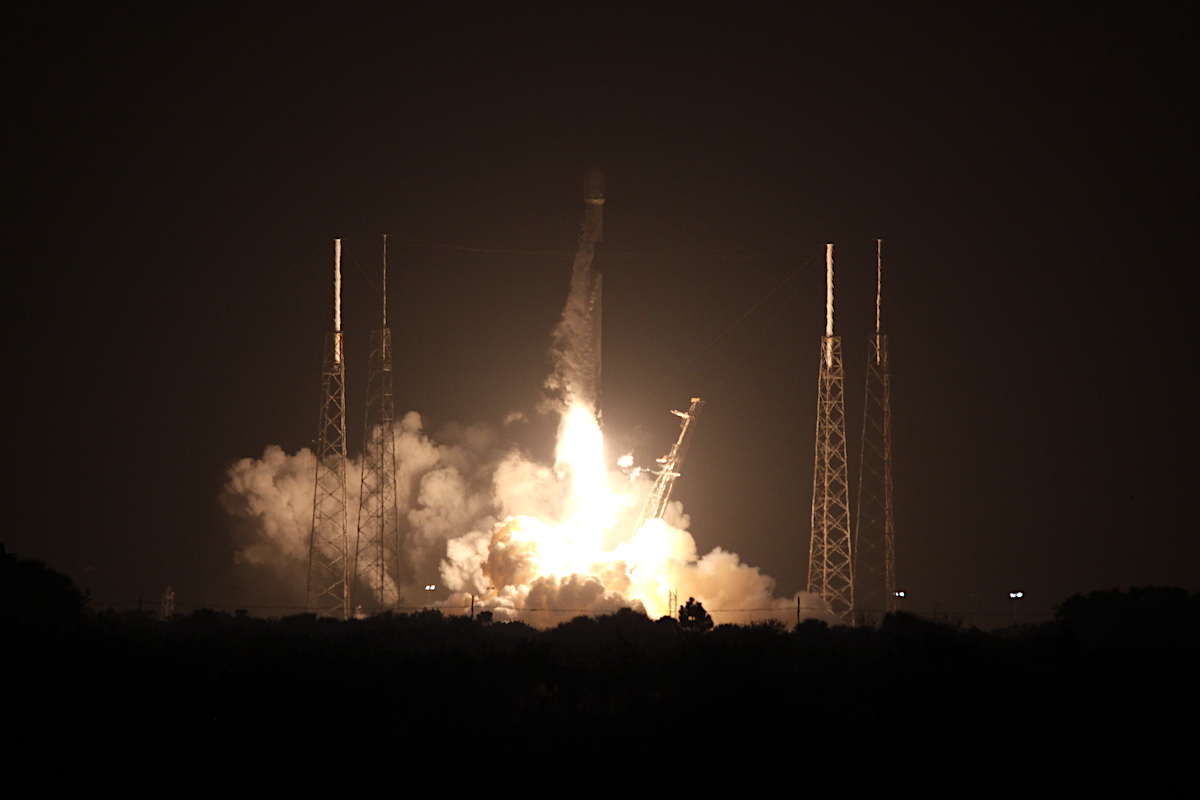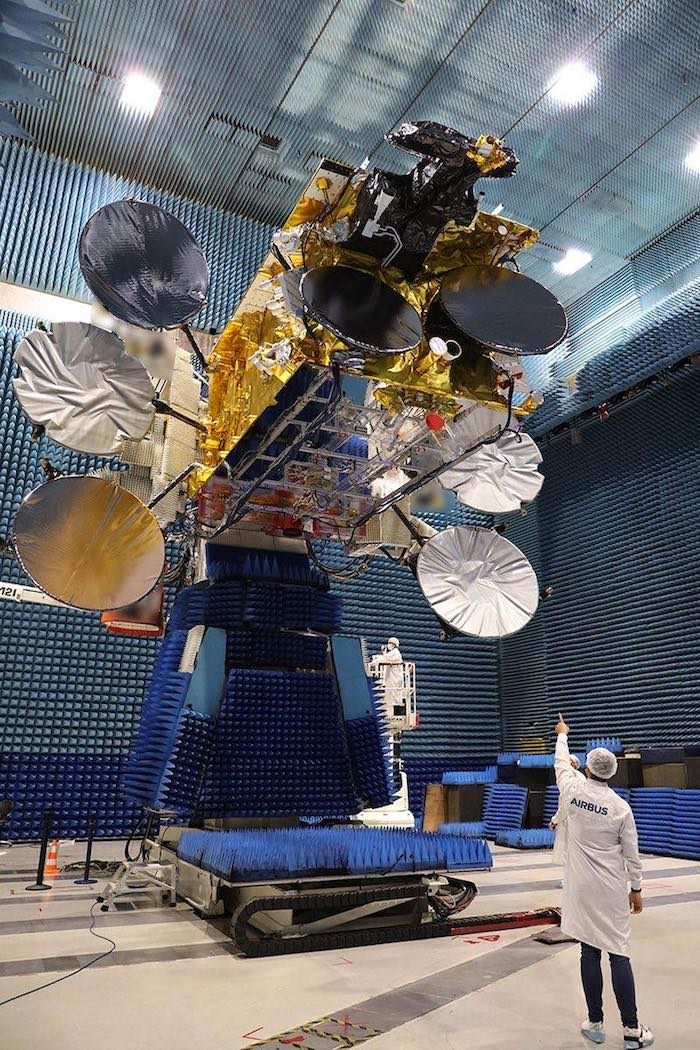
Fifteen hours after hurling a package of Starlink internet satellites into orbit from California, SpaceX launched a high-power geostationary communications spacecraft for Turkey from Cape Canaveral late Saturday, the first time two Falcon 9 rockets have flown on the same day.
The back-to-back launches from Vandenberg Space Force Base and Cape Canaveral Space Force Station — some 2,400 miles (3,800 kilometers) apart — made for a banner day in SpaceX history. The privately-held space company, founded and led by Elon Musk, plans to close out its 2021 launch schedule with another Falcon 9 mission Tuesday from Kennedy Space Center in Florida.
The day began with a predawn blastoff of a Falcon 9 rocket from Vandenberg at 7:41:40 a.m. EST (4:41:40 a.m. PST; 1241:40 GMT). The mission carried 52 flat-panel satellites into orbit for SpaceX’s Starlink internet network, and set a new record with the 11th flight of a reusable Falcon 9 booster, which landed again on a drone ship parked downrange in the Pacific Ocean.
SpaceX did it again Saturday night with the launch of a Falcon 9 from pad 40 at Cape Canaveral at 10:58:39 p.m. EST (0358:39 GMT Sunday). Like the Vandenberg launch earlier in the day, the Falcon 9 deployed its payload into an on-target orbit, and the reusable first stage landed at sea, this one completing a third trip to space and back.
Liftoff of SpaceX’s Falcon 9 rocket from Cape Canaveral with the Turksat 5B communications satellite, beginning the second Falcon 9 flight of the day from two different US spaceports. https://t.co/X33vxAZ3Vh pic.twitter.com/dZC91qeD7G
— Spaceflight Now (@SpaceflightNow) December 19, 2021
The launches were separated by 15 hours, 16 minutes, and 59 seconds, smashing SpaceX’s previous launch-to-launch turnaround record of about 44 hours, set in September. It’s a new rapid turnaround record for a private company’s rocket, but other launchers have achieved similar feats.
Russia has launched two Soyuz rockets from different launch sites on numerous occasions over the venerable vehicle’s history. Most recently, Soyuz rockets launched from pads at the Baikonur Cosmodrome in Kazakhstan and from French Guiana just two hours apart in 2013 and 2015.
The launch Saturday night delivered the Turksat 5B satellite into an on-target orbit to begin a mission relaying data and video across Turkey, the Middle East, large regions of Africa, and Asia.
Two burns with the Falcon 9 rocket’s second stage placed the Turksat 5B spacecraft into the proper orbit for separation nearly 35 minutes into the mission, while the vehicles soared over Africa. The Falcon 9 aimed to place the Turksat 5B satellite into a supersynchronous transfer orbit with a high point, or apogee, stretching tens of thousands of miles above Earth.
SpaceX reported the rocket hit its orbital target.

Built by Airbus on the Eurostar3000EOR satellite design, the Turksat 5B spacecraft weighs about 9,900 pounds (4.5 metric tons) and will operate in geostationary orbit more than 22,000 miles (nearly 36,000 kilometers) over the equator.
The Turksat 5B satellite will use its own electric propulsion system to gradually reshape its orbit to settle into an operating position at 42 degrees east longitude in geostationary orbit. Turksat 5B’s orbital velocity will match the rate of Earth’s rotation, giving the spacecraft a constant view of its coverage area.
The new satellite will be operated by Turksat, a state-owned communications satellite company in Turkey.
Turksat 5B carries Ku-band and Ka-band telecom payloads, providing more than 50 gigabits of data transmission capacity over its coverage area. SpaceX launched Turksat’s previous satellite, Turksat 5A, last January on a Falcon 9 launch from Cape Canaveral.
For the second time today, SpaceX has launched and landed an automated Falcon 9 booster on a drone ship.
This vehicle, designated B1067, is back on Earth after its third trip to space carrying Turksat 5B toward orbit.https://t.co/X33vxAZ3Vh pic.twitter.com/BrjEc06TLx
— Spaceflight Now (@SpaceflightNow) December 19, 2021
Turkish officials said Turksat 5B will operate for 35 years or more, a remarkable goal made feasible with the satellite’s use of an all-electric propulsion system. The design eliminates conventional liquid propellants that satellites typically use up faster.
“With Turksat 5B … we are increasing the number of active satellites in Turkey to eight,” said Adril Karaismailoğlu, Turkey’s minister for transport and infrastructure.
“With our new satellite, the existing Ka-band data transmission capacity will be increased by more than 15 times,” Karaismailoğlu said. “The internet and communication infrastructure in air, sea and land, where it is not possible to transmit communication by land, will be provided uninterrupted in any place within the coverage area of Turksat 5B.
Turksat 5B separation confirmed.
Turkey’s most powerful communications satellite has deployed from SpaceX’s Falcon 9 rocket.
The 9,900-pound (4,500-kg) satellite, built by Airbus, will use electric thrusters to reach geostationary orbit.https://t.co/X33vxAZ3Vh pic.twitter.com/IBUKHd5T9V
— Spaceflight Now (@SpaceflightNow) December 19, 2021
“With our satellite, we will be able to address the whole of the Middle East, the Persian Gulf, the Red Sea, the Mediterranean, North and East Africa, Nigeria, South Africa and its close neighbors, as well as Turkey,” he said. “Our satellite, which will serve for more than 35 years, will also take its place effectively in commercial sectors such as maritime and aviation.”
Turksat 5B’s electric propulsion thrusters, mounted on articulating pods, will spend about five months circularizing the spacecraft’s orbit before it can enter operational service next year. The new satellite will also provide backup service for Turksat 3A and 4A at 52 degrees east, officials said.
Airbus led development of the Turksat 5B spacecraft, but the manufacturing deal included an agreement for Turkish engineers to provide some of the components fo the satellite. Turkey is building its next geostationary communications satellite, named Turksat 6A, inside the country for a launch in 2023.

SpaceX plans to continue its launch cadence with its 31st and final Falcon 9 flight of the year at 5:06 a.m. EST (1006 GMT) Tuesday from pad 39A at NASA’s Kennedy Space Center. Like the two missions Saturday, SpaceX will aim to recover the first stage downrange.
Email the author.
Follow Stephen Clark on Twitter: @StephenClark1.
